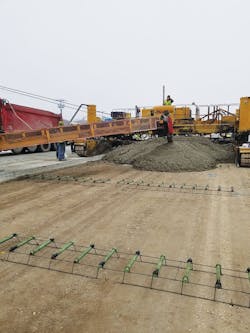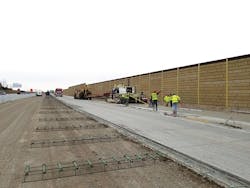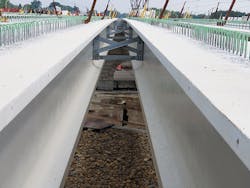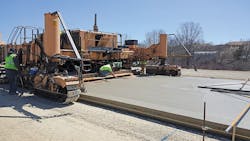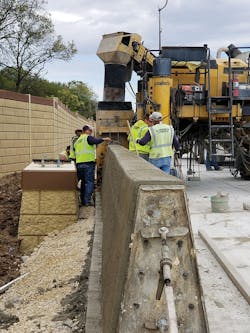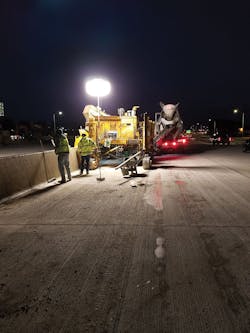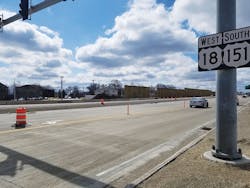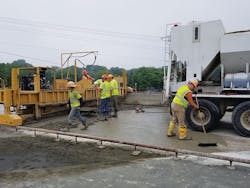Cost-effective, efficient concrete paving of Wisconsin’s Verona Road project, Stage 2
The U.S. 18/151 Verona Road project reconstructs one of the busiest corridors in Dane County and the Madison, Wisconsin metropolitan area.
Verona Road links major economic centers of northeastern Iowa, Madison, and the Fox Valley via the National Highway System and is a critical corridor in Dane County, the fastest-growing county by population in Wisconsin, double the rate of any other county in the state. Verona Road is also an important commuter corridor for major businesses in the area, including Sub Zero Inc. and Epic Systems—Dane County’s second largest employer with more than 10,000 employees. Verona Road and County PD carry approximately 56,000 and 34,000 vehicles per day, respectively, with nearly 10% truck traffic.
The $265 million Verona Road Project is part of the Wisconsin DOT’s (WisDOT) Majors Program and was divided into two stages. Stage 1 is complete and included the reconstruction of Verona Road between Raymond Road and the West Madison Beltline. Stage 2 included the reconstruction of Verona Road between County PD and Raymond Road, as well as a portion of County PD. Stage 2 was completed on time in November 2020 and under budget at $86.7 million.
Phased Approach
The Stage 2 project consists of the reconstruction of more than 2 miles of Verona Road and nearly a mile of County PD, including the addition of a single-point urban interchange (SPUI) at Verona Road and County PD and a tight urban diamond interchange (TUDI) at Verona Road and Williamsburg Way. It also includes collector-distributor (CD) lanes between County PD and Williamsburg Way; the reconstruction of Williamsburg Way, including a roundabout; a salt storage facility 1 mile south of the project site; and the reconstruction or new construction of several local roads, along with the addition of a pedestrian overpass on County PD.
The Verona Road Stage 2 project was sequenced into three significant bid lettings, with construction beginning in fall 2016. The prime contractor for Contract 1 was Speedway Sand & Gravel Inc. of Middleton, Wisconsin; and the prime contractor for Contracts 2 and 3 was Integrity Grading & Excavating Inc. (IGE) of Schofield, Wisconsin.
The four-year project was constructed while continuously maintaining two lanes of traffic in each direction, as well as access to nearby businesses on both Verona Road and County PD. To maintain the high traffic volumes, the contract documents included nearly 70 phases through the four years to complete various portions of the project while moving and shifting both the traffic and the contractors’ work operations throughout the corridor. The contractors had to be mobile in completing various portions of the project. For instance, there were sidewalks and lanes of concrete pavement placed in 2017 that were not used for phased traffic until 2019. In the end, the overall phasing plan was maintained with minor adjustments during construction.
“The complex project design included many stages and traffic patterns to facilitate the new construction, and also keep the corridor open to traffic, all while maintaining access to the local businesses,” said IGE Area Manager Thor Wick. “The success of the project showcases the great communication and coordination between contractors, design, project oversight, local residents, and businesses.”
Because of the significant phasing, contract documents for the project included meticulous consideration of the major bid items, especially the concrete paving. To provide economy of scale with unit bid prices, 10-in. concrete pavement was used throughout all portions of the project, including mainline Verona Road, the CD roads, the eight interchange ramps, and the concrete portions of the side roads. This also helped avoid costly setup changes to the paver itself and potential confusion related to the multi-phased project. The design team minimized the number of paving widths throughout the project to reduce the concrete paver downtime for changing over to different concrete pavement widths. Only three concrete widths of 12, 15, and 24 ft were specified for the through lanes and ramps, and concrete shoulders were limited to five different widths of 4, 6, 8, 10, and 12 ft to maximize paving efficiency. The paving contractor placed a central mix batch plant within 1,000 ft of the project for efficient access to the work site. CMI and GOMACO pavers were used for multilane paving, while Guntert & Zimmerman, RexCon, and GOMACO pavers were used for single-lane paving.
Construction Staging was Critical
Two construction staging alternatives were considered for Verona Road—half-at-a-time and outside-in construction. Each alternative was reviewed for constructability and costs associated with temporary work such as temporary earth retention systems, temporary pavement, and temporary concrete barrier.
It is common for construction staging to complete a project one-half at a time, constructing the off-alignment portions of a project first, then switching traffic to the newly constructed half and reconstructing the remaining portion of the roadway. Several factors reduced the efficiency of this approach for Verona Road, particularly the large amount of cut-and-fill required for the project. The conversion of the existing at-grade intersection at Williamsburg Way to a TUDI required Verona Road to be cut approximately 25 ft below existing grade. The County PD SPUI required Verona Road to pass over County PD, creating fills of approximately 25 ft. Building the roadway one-half at a time would have required large temporary earth retention systems for most of the project length, miles of temporary barrier wall to protect the retention system and miles of temporary pavement, and would have created significant temporary drainage issues, which would have added significant time and cost to the project.
Design firm Strand Associates Inc. solved these staging constraints by designing the construction of the project from the outside-in. Contract 1 took advantage of off-alignment areas to construct a new CD ramp system for northbound Verona Road from County PD to Raymond Road, and available ramp areas near the future County PD SPUI. Traffic remained on existing alignment during the construction of the off-alignment northbound CD ramp system in Contract 1.
In Contract 2, northbound traffic was shifted onto the completed northbound CD ramp system, and southbound traffic was shifted onto the existing northbound Verona Road pavement. This shift allowed for the cuts and fills required for the southbound CD ramp system to be constructed with minimal impacts to traffic.
In Contract 3, southbound traffic was then shifted onto the newly constructed southbound CD ramp system, while northbound traffic remained on the northbound CD ramp system. This allowed for the new Williamsburg Way bridge structure to be constructed without the need for extensive temporary retaining walls and temporary pavement. Another benefit of this approach was that it made the entire core of the project available to the contractor during Contract 3, where completing the large cut-and-fill and significant concrete paving afforded the contractor greater efficiency.
Construction of the Williamsburg Way overpass, a critical local connection across Verona Road, while maintaining traffic through the intersection, also required innovative construction staging. The newly constructed Williamsburg Way bridge remained at approximately the same elevation as the previous at-grade signalized intersection. A 25-ft cut was needed to relocate Verona Road traffic beneath Williamsburg Way. The west abutment of the bridge and the west retaining walls were in proximity to the CD ramps; therefore, these elements were constructed in several subphases, as follows:
Subphase 1
- Shift the at-grade signalized intersection to the north
- Install temporary shoring to construct the south half of the west bridge abutment and the south half of the west MSE retaining wall
- Bury the abutment and retaining wall using geotextile fabric and pea gravel to protect the MSE wall panels
- Install temporary shoring to support a temporary intersection to the south in Subphase 2
- Construct a temporary intersection on and over the buried elements
Subphase 2
- Relocate Williamsburg Way traffic to the south, over the buried abutment and retaining wall
- Construct the remaining west abutment and west retaining wall to the north while maintaining all traffic movements at Williamsburg Way
Subphase 3
- Shift Verona Road traffic onto the CD ramps
- Construct the east abutment, center bridge pier, and remaining bridge during a three-month closure restriction of Williamsburg Way to right-in/right-out access
The SPUI at Verona Road and County PD is the third SPUI in Wisconsin (the second was built in Stage 1 at Verona Road and the West Madison Beltline, a project covered in this magazine in 2017). Constructed with two, two-span structures carrying Verona Road 25 ft over County PD, the spans of the structures were maximized to 164 ft to accommodate the longest 72W prestressed concrete girders allowed by WisDOT’s Bureau of Structures. The SPUI accommodates three through lanes and dual left-turn lanes beneath the structures on County PD.
Community Involvement & Reaction
The project team initiated an extensive public involvement process to interact with the local governments, property owners, and businesses throughout the corridor, as well as the traveling public. Between December 2013 and November 2020, the design and construction team attended more than 300 meetings to coordinate the project details. The project also provided up-to-date local stakeholder interaction through a project website, Facebook page with more than 4,300 followers, and a weekly e-mail update for construction activities distributed to more than 3,000 subscribers.
Local businesses along the Verona Road corridor formed the Verona Road Business Coalition (VRBC) early in the design phase of the project to stay informed on the construction staging and schedule. This collaboration provided the VRBC and its members the opportunity to conduct proactive communication with their employees and customers. The VRBC sponsored numerous fundraising events over the years, and project staff attended various events with an informational booth about the major construction project. The construction team also met regularly with the VRBC to provide project updates and answer questions. Overall, the VRBC was instrumental in the success and coordination between WisDOT and the local community.
Since opening the project this past November, WisDOT has received dozens of positive comments of appreciation and gratitude regarding the project, among them:
“THANK YOU! It was a long road (no pun intended), but well worth it! Congratulations!”
“Congratulations and thank you! Your work has made life easier and safer for thousands of travelers every day.”
“Quite an accomplishment! The communications via email were always good. The best part was when I could start driving straight through from the Beltline to 18/151 without stopping, and vice-versa, from Mount Horeb. Saves me at least 10 minutes a day! Thank you for doing this. Great success!”
As is more than evident, WisDOT’s Verona Road Stage 2 project was an exemplary, cost-conscious project that, because of several innovative construction-related strategies, was successfully planned and executed and will provide long-lasting economic benefits for Wisconsin.
